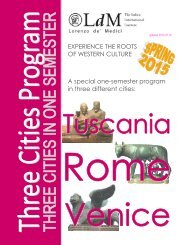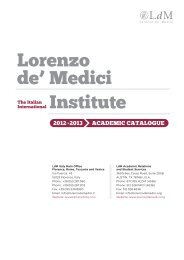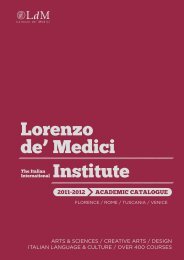aCademiC Catalog 2013-2014 - Lorenzo de Medici
aCademiC Catalog 2013-2014 - Lorenzo de Medici
aCademiC Catalog 2013-2014 - Lorenzo de Medici
You also want an ePaper? Increase the reach of your titles
YUMPU automatically turns print PDFs into web optimized ePapers that Google loves.
exemplary. Factors including the rise of the mendicant or<strong>de</strong>rs,<br />
the affirmation of the Comune or municipality, and private<br />
wealth generated by the wool-tra<strong>de</strong> and banking, directly<br />
encouraged artistic patronage and changed the role of the<br />
artist. While many civic and monastic commissions altered<br />
the physical aspect of Florence in important ways, private<br />
commissions in the form of palaces, chapels, and altarpieces<br />
served spiritual as well as family needs. A premise of the course<br />
is that in many cases artworks combine painting, sculpture and<br />
even architecture, in ensembles. For this reason, many lessons<br />
involve direct observation of works “in situ” in their unique<br />
physical contexts.<br />
Prerequisites: ART 180 Art History I, or equivalent<br />
Artists in Italy Today<br />
ART 310 F<br />
Cr: 3; Contact hrs: 45<br />
This course examines the latest trends in the arts of<br />
contemporary Italy through the direct experience of the work of<br />
living artists. Has globalization abolished the barriers between<br />
countries and continents? The so-called “globish” (globalized<br />
artistic languages) has been replacing regional languages, on<br />
the one hand leveling experiences, on the other allowing more<br />
exchange and interaction between peoples of different and<br />
distant geographical areas. How does the art world respond to<br />
this process of globalization? How do today’s artists from Italy,<br />
a country with such an important cultural heritage, position<br />
themselves, maintaining their own individuality and regional<br />
traits, while at the same time engaging with a global panorama<br />
that tends to flatten differences? Stu<strong>de</strong>nts in this course will<br />
analyze the work of important Italian artists today. They will<br />
have the opportunity to become familiar with the strategies<br />
and means they adopt: mixed media, vi<strong>de</strong>o, digital art, as<br />
well as the more traditional media of painting and sculpture.<br />
Part of the course will inclu<strong>de</strong> direct encounters with cuttingedge<br />
contemporary artists who will personally illustrate their<br />
tensions, aesthetics, and production. Meetings will take place<br />
either in their studios or in class and are organized in or<strong>de</strong>r<br />
to allow direct engagement with these leading figures of the<br />
Italian and international art scene. This course is particularly<br />
suitable for stu<strong>de</strong>nts interested in becoming artists and gallery<br />
curators as well as those with an interest in the history of art.<br />
Prerequisites: two Art History courses<br />
Hid<strong>de</strong>n Meanings in Renaissance Art<br />
ART 320 F<br />
Cr: 3; Contact hrs: 45<br />
This course introduces stu<strong>de</strong>nts to the richness and complexity<br />
of Renaissance art, focusing mainly on iconography and<br />
iconology. Stu<strong>de</strong>nts will learn how to un<strong>de</strong>rstand major works<br />
of Renaissance art (mainly paintings) within the context of<br />
religious, classical and humanistic elements of 15th- and 16thcentury<br />
culture. The course is based on a series of case studies<br />
which are investigated weekly, and will inclu<strong>de</strong> masterpieces<br />
by Jan Van Eyck, Piero <strong>de</strong>lla Francesca, Sandro Botticelli,<br />
Michelangelo and Holbein. The works chosen <strong>de</strong>monstrate how<br />
the system of Renaissance figurative arts, full of symbols and<br />
allegories, was meant to be un<strong>de</strong>rstood by a learned public.<br />
Each work will be analyzed with reference to the three levels of<br />
meaning involved in an iconographic approach as <strong>de</strong>fined by<br />
Erwin Panofsky: primary or natural subject matter, secondary<br />
or conventional, and intrinsic meaning or context.<br />
Prerequisites: ART 180 Art History I, or ART 186 Art History II,<br />
or equivalents<br />
Renaissance Art at the Italian Courts<br />
ART 330 F<br />
Cr: 3; Contact hrs: 45<br />
This course explores all aspects of artistic activity at the major<br />
Italian courts during the fifteenth century. This analysis will not<br />
only be confined to an art historical approach, but will also<br />
consi<strong>de</strong>r various aspects of court life - the chivalric tradition,<br />
hunting, jousting, scholarship, and court festivals - which have<br />
an influence on the visual arts. Comparisons will be ma<strong>de</strong><br />
with Northern European courts of the same period. The main<br />
focus of attention will be Pisanello and the courts of Ferrara<br />
and Mantua, Mantegna and the Gonzaga court in Mantua,<br />
Francesco Cossa at the D’Este court in Ferrara, Piero <strong>de</strong>lla<br />
Francesca and Laurana at the court of Fe<strong>de</strong>rigo da Montefeltro<br />
in Urbino, and Piero <strong>de</strong>lla Francesca and Alberti at the<br />
Malatesta court in Rimini. The stu<strong>de</strong>nt will become familiar with<br />
the special patronage conditions which dictated the nature of<br />
Renaissance art at the princely courts of Italy. The stu<strong>de</strong>nt will<br />
have a <strong>de</strong>tailed knowledge of the work of five court artists and<br />
a broa<strong>de</strong>r familiarity with three others.<br />
High Renaissance and Mannerism<br />
ART 340 F<br />
Cr: 3; Contact hrs: 45<br />
This course traces the major trends of Italian art in the sixteenth<br />
century. It is a period dominated by the achievements of<br />
Leonardo da Vinci, Raphael, Titian, and above all, Michelangelo.<br />
These three artists are examined in great <strong>de</strong>tail. This analysis<br />
is not confined to their works of art, but also inclu<strong>de</strong>s their<br />
personalities and the social framework within which they<br />
lived and worked. Great emphasis is therefore put on the dual<br />
themes of patronage and the social position of the artist in<br />
the period. The course also explores the complex and refined<br />
style known as Mannerism - a style held to have emerged from<br />
ten<strong>de</strong>ncies present in Michelangelo’s work. Stu<strong>de</strong>nts learn to<br />
i<strong>de</strong>ntify and examine in <strong>de</strong>tail the works of the leading artists<br />
of the period, and gain the ability to discuss High Renaissance<br />
and Mannerist <strong>de</strong>velopments of major subjects and genres,<br />
such as portraiture and the nu<strong>de</strong>. In the host city stu<strong>de</strong>nts visit<br />
various unique churches, galleries, resi<strong>de</strong>nces, and squares<br />
related to the period, and examine in person masterworks by<br />
representative artists.<br />
Prerequisites: ART 180 Art History I, or ART 186 Art History II,<br />
or equivalent<br />
Baroque Art<br />
ART 350 F<br />
Cr: 3; Contact hrs: 45<br />
This course covers the Baroque style in art and architecture,<br />
with with particular emphasis on seventeenth-century Italy. This<br />
consi<strong>de</strong>ration of Baroque art is not only limited to a stylistic<br />
analysis but involves continual reference to the religious,<br />
political, cultural and social framework of the period. The<br />
social rise of the artist in the seventeenth century is illustrated<br />
through the career of Bernini. Special focus is placed on major<br />
artists including Carracci, Caravaggio, Bernini, Borromini,<br />
Pietro da Cortona and their workshops, and on their role in the<br />
<strong>de</strong>velopment of a wi<strong>de</strong>r Italian and European artistic language.<br />
Stu<strong>de</strong>nts will become familiar with the main characteristics<br />
of the Baroque style and with key issues and trends and<br />
issues, such as iconography and emblem culture, Naturalism,<br />
Classicism, and Triumphalism.<br />
Prerequisites: ART 180 Art History I, or ART 186 Art History II,<br />
or equivalents<br />
Images and Words<br />
ART 355 F; Dual listed: CLT 355 F<br />
Cr: 3; Contact hrs: 45<br />
In this interdisciplinary course different disciplines converge<br />
to enhance stu<strong>de</strong>nts’ skills as rea<strong>de</strong>rs of visual as well as<br />
verbal texts. It aims to open up new ways of seeing and<br />
perceiving works of art by exploring the relationship between<br />
us (spectators and/or creators), images and words, involving<br />
questions such as What is art? Where do we see art? How do<br />
we look at art? What words do we use while talking about a<br />
work of art, explaining and/or <strong>de</strong>scribing it? Can we “read”<br />
images? Can we “see” stories? Stu<strong>de</strong>nts analyze a selection of<br />
fundamental theoretical texts and produce close examinations<br />
of visual and written works, including narrative prose and poetry.<br />
Stu<strong>de</strong>nts have the opportunity to become active spectators<br />
who, through activities of observing, reading, sketching and<br />
writing, experience different mo<strong>de</strong>s of looking at art while<br />
learning about art theory, art history, literature, museum culture<br />
and sociology.<br />
Prerequisites: Junior standing<br />
Museum Experience<br />
ART 360 F<br />
Cr: 3; Contact hrs: 135<br />
The course entails individual work experience in a museum or<br />
School of Arts & Sciences FLORENCE<br />
LdM Aca<strong>de</strong>mic <strong>Catalog</strong> <strong>2013</strong>-<strong>2014</strong><br />
55





